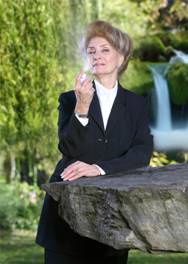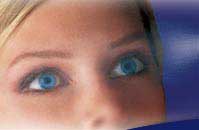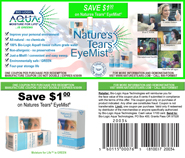
FOR IMMEDIATE RELEASE - February 21, 2012
Rogue Media
541-474-0950
New Education from Sharon Kleyne on the
Structure and Care of the Eyes' Tear Film
In Our Changing Global Climate, Everyone Should be Educated about Dry Eye, Eye Hydration and Tear Film Health, Says Bio-Logic Aqua Research Founder
Hear the Sharon Kleyne Hour Power of Water on World Talk Radio, Voice America, Green Talk Network and Apple iTunes
According to Sharon Kleyne, Founder of Bio-Logic Aqua Research, Inc., sustained global changes in temperature, humidity and air pollution, are producing a worldwide health crisis in dry eye disease. The key to maintaining healthy eyes and good vision could come down to education about the structure and care of the eyes all-important tear film.
The eye (including the white sclera and clear cornea) is the only exposed part of the body not protected by skin. Instead, it is protected by the tear film, which is 99% water. The tear film also lubricates the eyes and is the primary light transmitter.

Our increasingly dry and polluted global environment is creating a heightened risk of tear film water loss to evaporation. When the tear film loses water, it doesn't perform its many of its functions as well and vision can become compromised.
The first and most important step in preventing dry eye and tear film moisture loss, according to Sharon Kleyne, is to understand how the tear film works.
Although only 20 to 30 microns (millionths of a meter) thick, the multi-layered tear film is amazingly complex. Dehydrated and eye irritation irritated eyes (dry eye) mainly occur as moisture loss in the tear film's middle (aqueous) layer.
Tear film layers:
Lipid layer. This outermost layer consists of a thin film of fatty oils (over 100 different fats and oils have been identified), that lubricate the eyelid, help protect the eye from airborne particles (dust, pollen, smoke, bacteria, etc.), and slow evaporation of water from the aqueous layer.
Aqueous layer. The middle and by far the thickest tear film layer contains the vast majority of its water. It also contains electrolyte (salt), beneficial proteins and enzymes, and bacteria-fighting antibodies. Moisture loss from the aqueous layer can lead to an over-concentration of salt that results in discomfort (usually burning). Perspiration also contains lipid, salt and water but the salt content is much higher than that of the tear film. That's why perspiration causes discomfort when it drips into the eyes.
Since the clear corneal cells are live but contain no blood vessels, they depend on the aqueous layer's water for nutrition and oxygen. The water is most oxygenated when there is a steady inflow of clean humidity droplets, passing through the lipid layer, from the surrounding air.
Mucin layer. This bottom layer glues the tear film to the ocular surface.
Sharon Kleyne's radio talk show, Sharon Kleyne Hour Power of Water, is sponsored by Bio-Logic Aqua Research, whose Nature's Tears® EyeMist® is the only all-natural, all water eye mist that is patented and specifically configured to soothe dry eye symptoms and supplement tear fom water. Nature's Tears® EyeMist® is available at www.BioLogicAqua.com, Amazon.com, drugstore.com and selected drugstores nationwide.
Listen to the Sharon Kleyne Hour Power of Water Mondays, 10 a.m., PST/PDT. The syndicated radio talk show is heard on Voice America/World Talk Radio, Green Talk Network and Apple iTunes. Go to www.SharonKleyneHour.com for written summaries and on-demand replays. Also visit www.naturestears.com, whatistheeye.wordpress.com, "Nature's Tears EyeMist" on Facebook and "Bio-Logic Aqua" on Twitter.
© 2012 Bio-Logic Aqua Research (113)









